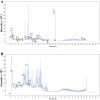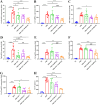Shu-Feng-Jie-Biao Formula Ameliorates Influenza A Virus-Induced Acute Lung Injury by Inhibiting NF-κB and ERK MAPK Signaling Pathways
- PMID: 40771428
- PMCID: PMC12325107
- DOI: 10.2147/IDR.S499548
Shu-Feng-Jie-Biao Formula Ameliorates Influenza A Virus-Induced Acute Lung Injury by Inhibiting NF-κB and ERK MAPK Signaling Pathways
Abstract
Purpose: Shu-Feng-Jie-Biao formula (SFJBF) has been used to treat acute respiratory infections for a dozen years. This study aimed to explore its mechanisms and effects for the treatment of influenza.
Methods: Network pharmacology was used to explore the underlying mechanism of SFJBF against influenza. The protective effects of SFJBF in vivo were evaluated by lung indexes, body weight loss and pathological changes in lungs. The anti-inflammatory effects in vivo were evaluated by flow cytometry and ELISA. RAW264.7 cells stimulated with imiquimod (R837) were used to determine the anti-inflammatory effects of SFJBF. Neutrophils isolated from bone marrow were activated by phorbol 12-myristate 13-acetate (PMA) to validate the effects of the active components of SFJBF.
Results: SFJBF protected body weight loss, decreased lung indexes, reduced total protein content in lungs and mitigated pathological changes in mice. SFJBF inhibited the expression of chemokines (Cxcl2 and Ccl2) and cytokines (Il1b and IL-6) accompanied by the decreased infiltration of neutrophils in lungs. SFJBF inhibited the expression of iNOS and MPO in lungs. The synergistic role of OSV and SFJBF was exhibited by suppressing virus-induced cytokine expression and reducing the infiltration of inflammatory monocytes in lungs. SFJBF inhibited the phosphorylation of ERK1/2 and NF-κBp65, thereby reducing the secretion of MIP-2, TNF-α, MCP-1 and CCL5 in vitro The active components of SFJBF, including baicalin and wogonin, reduced the production of reactive oxygen species (ROS), MIP-2, MCP-1, and IL-6 in vitro.
Conclusion: SFJBF ameliorated virus-induced lung injury by suppressing overactivated immune responses via NF-κB and ERK MAPK signaling pathways, thereby protecting mice from influenza virus infection. SFJBF could be considered a potent therapeutic agent for treating influenza.
Keywords: ERK MAPK signaling pathway; NF-κB signaling pathway; TCM; acute lung injury; anti-inflammatory; influenza virus; traditional Chinese medicine.
© 2025 Lei et al.
Conflict of interest statement
The author(s) report no conflicts of interest in this work.
Figures












Similar articles
-
Mahonia bealei (Fort.) Carr. Leaf extract modulates the TLR2/MyD88/NF-κB signaling pathway to inhibit PGN-induced inflammation in RAW264.7 cells.J Ethnopharmacol. 2025 Mar 26;344:119510. doi: 10.1016/j.jep.2025.119510. Epub 2025 Feb 17. J Ethnopharmacol. 2025. PMID: 39971016
-
The mechanism of action in Mussaenda pubescens (Yuye Jinhua) against influenza A virus: Evidence from in vitro and in vivo studies.Phytomedicine. 2025 Sep;145:157070. doi: 10.1016/j.phymed.2025.157070. Epub 2025 Jul 13. Phytomedicine. 2025. PMID: 40684492
-
Fici hirtae radix alleviates influenza A virus-induced acute lung injury via TLR4-PI3K-AKT/p38 MAPK-NF-κB signaling pathway.J Ethnopharmacol. 2025 Sep 1;354:120522. doi: 10.1016/j.jep.2025.120522. Online ahead of print. J Ethnopharmacol. 2025. PMID: 40902813
-
Nicotinic acid from Bubali Cornu alleviates H1N1-induced acute lung injury via dual antiviral and anti-inflammatory actions: A bioactivity-driven discovery.J Ethnopharmacol. 2025 Aug 29;352:120222. doi: 10.1016/j.jep.2025.120222. Epub 2025 Jun 28. J Ethnopharmacol. 2025. PMID: 40588145
-
Investigation of the effect and mechanism of Fei Re Pu Qing powder in treating acute lung injury (ALI) by modulating macrophage polarization via serum pharmacology and network pharmacology.J Ethnopharmacol. 2025 Jul 24;351:120089. doi: 10.1016/j.jep.2025.120089. Epub 2025 Jun 9. J Ethnopharmacol. 2025. PMID: 40499803
References
-
- Uyeki TM, Bernstein HH, Bradley JS, et al. Clinical practice guidelines by the infectious diseases society of America: 2018 update on diagnosis, treatment, chemoprophylaxis, and institutional outbreak management of seasonal influenza. Clinl Infect Dis. 2019;68(6):e1–e47. doi: 10.1093/cid/ciy866 - DOI - PMC - PubMed
LinkOut - more resources
Full Text Sources
Research Materials
Miscellaneous

